Category: General
There’s a snake in my boot – Key military leaders assist with tagging and the study of rattlesnakes
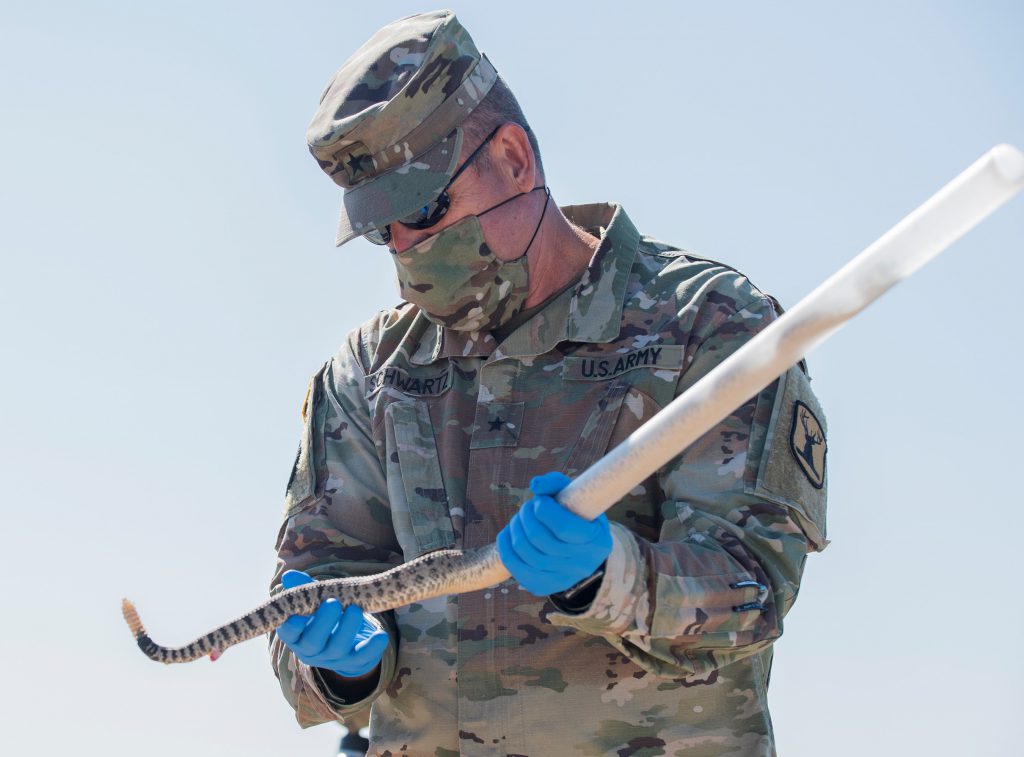
By Master Sgt. Becky Vanshur
Idaho Military Division Public Affairs
Although snakes did not end up in anyone’s boots as the popular phrase states, they did end up in key leaders’ hands. Idaho National Guard key leaders held rattlesnakes and assisted the Idaho National Guard Environmental Management Office biologists with tagging, studying and measuring rattlesnakes on July 8, at the Morley Nelson Snake River Birds of Prey National Conservation Area, locally known as the NCA.
Snakes have been an ongoing national and local interest with a legacy project directed by the Department of Defense due to a common snake fungal disease that affected preservation and spread in the United States. Biologists here continue to test and study rattlesnakes for the fungal disease.
“We train to protect our nation’s interests and the preservation of our environment is, and should be, one of our most important national interests,” said Maj. Gen. Michael Garshak, adjutant general of Idaho. “We don’t take care of the environment in order to train, we train to preserve the environment.”
The Idaho National Guard continues to partner with the Bureau of Land Management and other agencies to protect the NCA’s natural and cultural resources while simultaneously training in what is one of the largest northwest joint combined arms military training sites; the Orchard Combat Training Center.
The OCTC’s 143,000 acres has provided training grounds for the Idaho Army National Guard and air combat training for the Idaho Air National Guard, as well as neighboring states, since 1953.
The current program study, run by Boise State University graduate student, Kristina Parker, is a collaborative partnership between the IDARNG, BSU, U.S. Geological Survey and Northern Nazarene University, funded by the IDARNG. IDARNG biologists have collected data on the environment in the NCA, in accordance with Department of Defense requirements, as part of an ongoing comprehensive study of the land since 1987.
“Our data shows that the base of this environment, which is the vegetation, has had positive effects over this amount of time,” said Zoe Duran, Idaho National Guard Management Office biologist. “This is because of the resources we are able to put into wildland fire prevention and active restoration of the vegetation.”
The NCA is home to one of largest North American populations of breeding raptors, to include hawks, falcons, eagles and owls.
Idaho National Guard biologists conduct studies to ensure a robust and abundant diet for the birds of prey, like snakes, ground squirrels and lizards, which promotes conservation of the overall wildlife and their habitats within the NCA. The Idaho National Guard ensures the land is well-maintained with healthy vegetation to sustain a balanced ecosystem.
“The military has been known for doing a great job of maintaining their natural resources and conserving the natural landscape of their training areas,” said Kevin Warner, the Idaho National Guard’s Environmental Management Office natural resource specialist.
The NCA is a unique place in Idaho that can sustain the natural birds of prey and other wildlife, while sharing the land with livestock, public land use and military training at the OCTC.
Idaho National Guard key leaders and biologists recorded the health of each of the rattlesnakes they studied and tagged new snakes they found. Fortunately, no one ended up with a snake in his or her boot and the ongoing efforts of good environmental stewardship continued by gaining valuable data from another successful day in the NCA.
Idaho Guardsmen train to fight wildland fires earning Red Card certifications
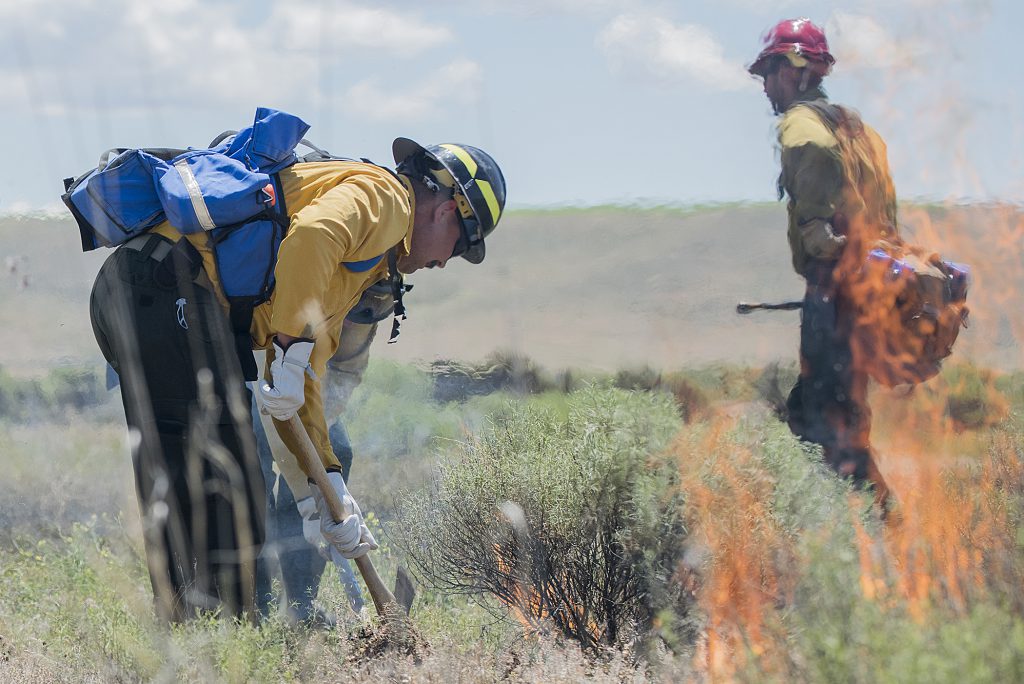
By Master Sgt. Becky Vanshur
Idaho Military Division Public Affairs
Approximately 40 Idaho Citizen-Solders are now equipped with the knowledge and training to fight wildland fires, as the Idaho National Guard hosted its first wildland firefighting training course at Gowen Field, Idaho, June 15-19 and June 22-26.
Although Gowen Field and the Orchard Combat Training Center fire departments have qualified wildland firefighters, this is the first time the five-day courses have been offered to non-firefighter Guardsmen, enabling them the opportunity to earn an Incident Qualification Card, commonly known as a Red Card certification.
As Soldiers become certified by Idaho Department of Lands, they are prepared to assist firefighting efforts in the event the governor declares a state emergency. Additionally, it allows the Guardsmen the opportunity to learn a new skill they can use for job opportunities within the military or the civilian workforce.
“The Idaho National Guard is proud to offer our Soldiers the opportunity to participate in this entry-level firefighter course,” said Brig. Gen. Russ Johnson, director of the joint staff. “It enables us to enhance our capability to respond to local, state and federal calls with trained and qualified wildland firefighters.”
The Soldiers who were willing and able to complete training standards for this course are also willing and able to volunteer for state activation during the fire season, Aug. 1 through Nov. 30 of this year, if requested.
“We want to train and Red Card certify as many as 200-300 Guardsmen over the next several years,” said Lt. Col. Tony Vincelli, director of strategic plans for the joint staff. “It’s part of our overall strategy that the Idaho National Guard be prepared to support any domestic emergency.”
The week consisted of two online introduction courses leading into 32 hours of training in the Basic Firefighting and Wildland Fire Behavior courses and the demonstration of individual physical fitness by completing a pack test consisting of a three-mile ruck march carrying a 45-pound pack in less than 45 minutes.
“I have always been one to just go for it and volunteer for everything,” said Spc. Tatiana Campbell from Bravo Company, 116th Brigade Engineer Battalion. “As one of the few females signed up for the course, I was pretty impressed with the physical challenge of it. Physically it wasn’t too hard on me, but if you are physically fit, it’s going to be easier on you.”
National Guard Bureau provides funding for specific wildfire prevention and protection activities. These courses were offered at Gowen Field at no cost to the Idaho Guardsmen. When available, this funding is provided annually to Idaho and other western states prone to wildland fires.
“Wildland firefighting is something I have always wanted to do,” said Sgt. Nolan Myer from the 148th Field Artillery Regiment. “Within 45 minutes of getting the email that there was a wildland firefighting course being offered, I sent an email immediately back and signed right up.”
The IDL and the OCTC firefighters taught the course and at the end of each of the weeklong courses, the IDL certified those individuals who met the qualifications and issued their Red Cards. Every year those individuals can recertify to maintain their skills and Red Card certification.
“This unique training compliments the existing levels of specialized capability that currently exist in the Idaho National Guard,” said Johnson. “And it further reinforces our commitment to serving and protecting our great citizens.”
New Idaho Guard enlistees receive school tuition assistance, $20,000 bonus
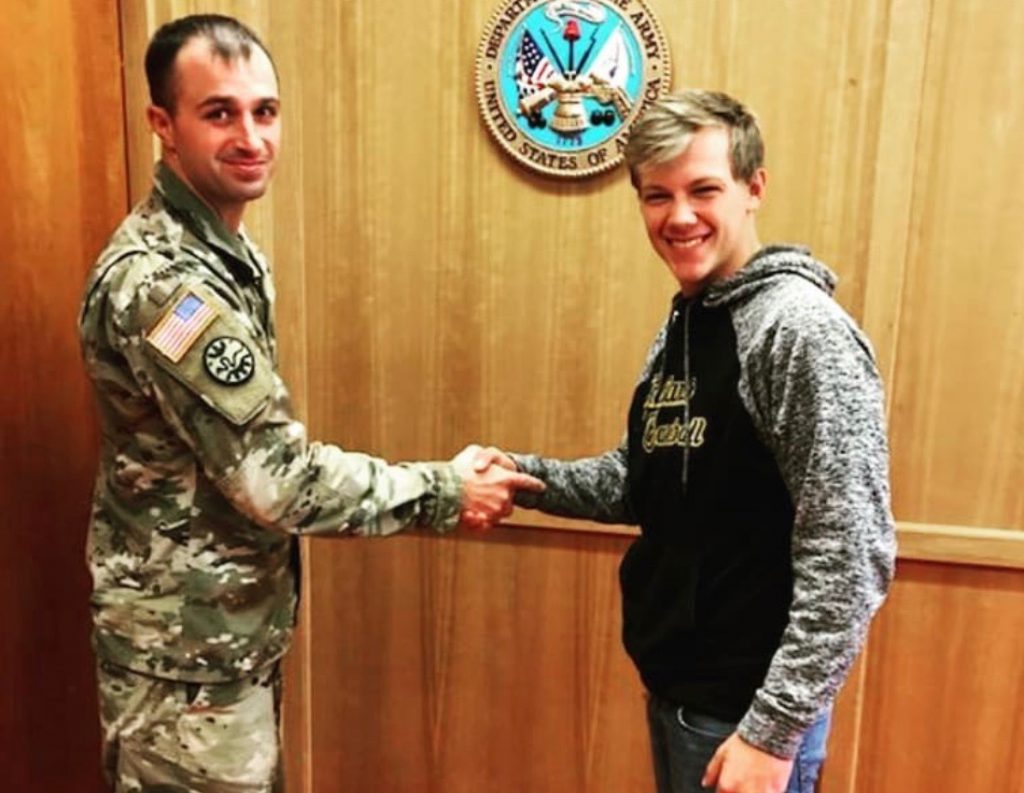
Story by Crystal Farris
Idaho Military Division Public Affairs
Idaho Army National Guardsman Pfc. Kolten Jordan needed a bit of direction in his life after graduating high school. Working full time in the construction industry just to make ends meet, he decided to find a more enjoyable career and a way to help pay for college.
“I really wanted to go to school to get a degree,” said Jordan. “After hearing that I could receive an enlistment bonus and college tuition benefits through the guard, I knew it would be a good direction to take in my life.”
Jordan enlisted as a cannon crew member with the 116th Cavalry Brigade Combat Team’s A Battery, 148th Field Artillery Regiment in November 2018. Upon joining, he received a $20,000 enlistment bonus, the Montgomery GI Bill Kicker of $350 per academic month and the ability to earn an additional $8,000 in annual federal and state tuition assistance.
Since returning from basic and advanced individual training, Jordan has started using his school tuition assistance to pursue an associate degree in fire science at Boise State University and has received $10,000 of his enlistment bonus.
“Receiving my bonus was one of the biggest reliefs I’ve ever had,” said Jordan. “The money has so far helped me pay for college, enabled me to give my girlfriend a good birthday and is still helping to keep me on my feet with bills while I focus on school.”
The Idaho Army National Guard is one of approximately five other states national-wide to offer a $20,000 non-prior service enlistment bonus as part of a new pilot program that began in October 2018. The organization has since signed 93 enlistees under the bonus.
“The bonus program is just one example of how the Idaho Army National Guard helps Soldiers accomplish whatever they want in their civilian life,” said Brig. Gen. Farin Schwartz, commander, Idaho Army National Guard. “The benefits of our organization make the Guard an easy first choice for Idahoans who want to serve their country while remaining close to home.”
The bonus incentivizes Soldiers to maintain good standing throughout their commitment by changing the way it pays over the course of six years compared to previous bonuses. Previous bonuses paid service members half their entitlement after completing advanced individual training and the remaining half in even allotments every two years for the remainder of their contracts.
While the new bonus also pays out half after AIT, service members now receive the second half in even allotments dispersed annually on the anniversary of their AIT graduation, but only if they are in good standing.
By issuing payments every year, the bonus gives service members money they can count on more frequently, said Sgt. Preston Hair, Idaho Army National Guard recruiter. It’s an added benefit to fulfilling requirements service members are already expected to meet regardless of a bonus, added Hair.
“I’ve always been someone who wants to get a job done well but the bonus payments definitely help motivate me to maintain good readiness standing with the guard,” said Jordan. “It’s always nice to receive a payment, especially for doing something that I absolutely love being a part of.”
To qualify for the enlistment bonus, individuals must meet various initial entry requirements, including: no prior military service, score above a 50 on the ASVAB and have either a high school diploma or a GED in combination with 15 or more college credits.
Additionally, enlistees must sign for six years and chose from a list of the organization’s 10 to 15 qualifying military occupational specialties.
The organization also offers educational incentives to those qualifying under the new pilot program bonus, including the Montgomery GI Bill Kicker of up to $350 per academic month and a student loan repayment program that pays up to $50,000 in previously acquired academic loans. This is in addition to $4,000 in federal educational assistance and $4,000 in state educational assistance service members are already entitled to per year.
Idaho National Guard sends 400 Soldiers to Washington D.C.
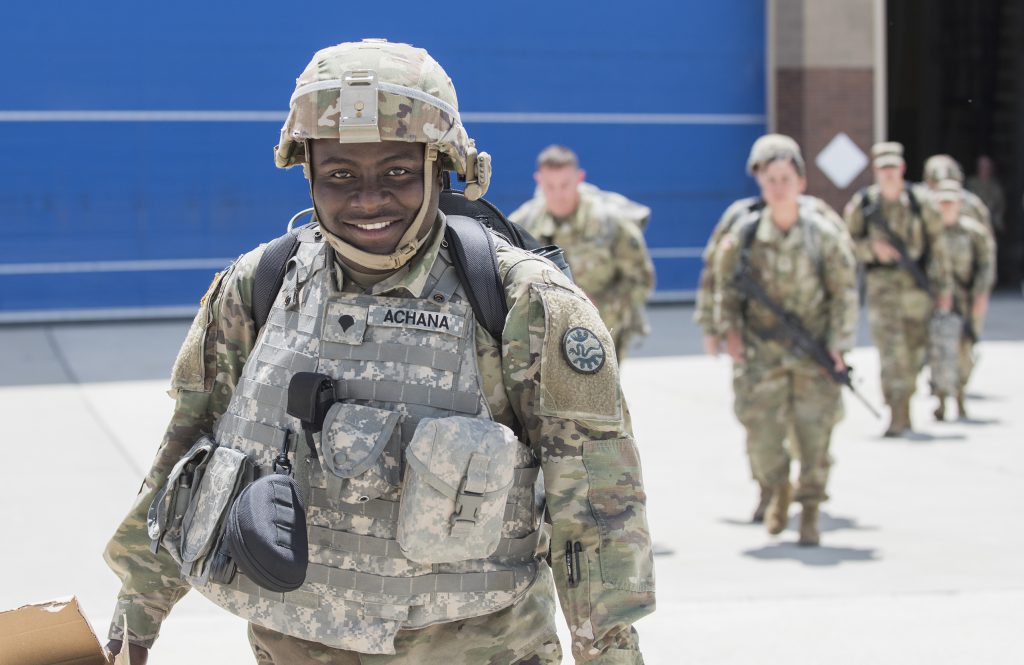
The Idaho National Guard sent approximately 400 Soldiers to Washington D.C. today to assist with guarding federal monuments, buildings and other property. The Soldiers will augment the D.C. National Guard and serve in support of the United States Park Police and Metropolitan Police Department.
Soldiers departed from Gowen Field, Pocatello and Spokane less than 25 hours after the mission was approved by Gov. Brad Little. Idaho is one of 11 states to send additional support to the nation’s capital.
“The key to being successful in this mission, and it’s a tough mission, is your professionalism,” said Maj. Gen. Michael Garshak, adjutant general of Idaho and commander of the Idaho National Guard. He addressed the Soldiers before they departed from Gowen Field. “I have all the confidence in the world that this group in front of me, from the leadership down, are professional Idaho National Guardsmen.”
Idaho National Guardsmen are trained to protect life and to preserve property, peace and public safety while respecting the right of the American public to peaceably assemble.
“Whether responding to a crisis in Idaho or another state, the principles of the Idaho National Guard remain the same: to help local jurisdictions, city governments and state agencies ensure public safety,” said Garshak. “Regardless of where we are in the U.S., our role is to support civilian authorities and our personnel are trained to protect life, preserve property and ensure people’s right to peacefully demonstrate.”
The Idaho National Guard has deployed out of state in support of national emergencies in the past. From Hurricane Katrina in 2005, wildland fire suppression in Oregon and Washington in 2015, to Puerto Rico for Hurricane Maria recovery support in 2017, the Idaho National Guard has provided hundreds of Soldiers and Airmen over the last decade in response to national emergencies. More recently, the Idaho National Guard provided state emergency relief here at home during the COVID-19 pandemic.
IDAHO AIR NATIONAL GUARD’S 124TH FIGHTER WING DEPLOYS TO SOUTHWEST ASIA
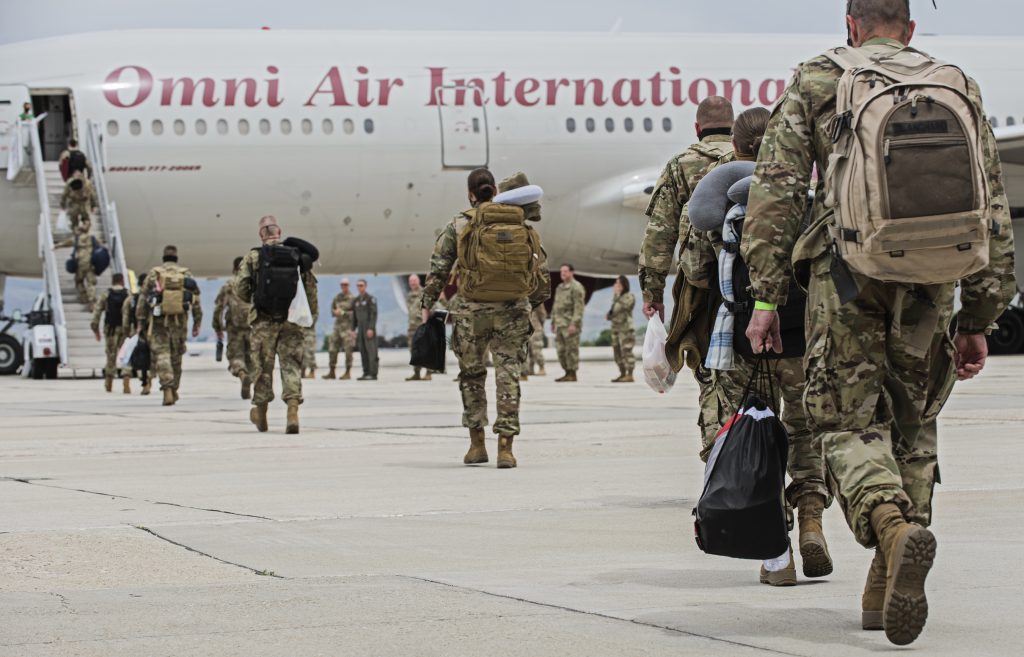
The Idaho Air National Guard deployed to various locations throughout Southwest Asia in support of combat operations on May 11.
More than 400 members of the 124th Fighter Wing, based at Gowen Field, will continue to deploy throughout the spring and summer in support of Operations FREEDOM’S SENTINEL, INHERENT RESOLVE and NEW NORMAL.
“We recognize the impact this mission will have on our community and we deeply appreciate the sacrifice of Idaho’s service members,” Idaho Gov. Brad Little said. “This deployment once again displays the commitment of the 124th Fighter Wing and its members, as well as the dedication demonstrated by the community of families, state and local leaders, neighbors and employers who provide unwavering support to our service members.”
The deployment is the wing’s second largest deployment and includes multiple aircraft, pilots, security forces, maintenance and medical personnel, and various other support staff. The official sendoff took place May 11 with the departure of the main body of personnel.
Deploying Airmen received farewell comments from Idaho National Guard leadership, including Little, Idaho’s commander in chief, and the Adjutant General of Idaho Maj. Gen. Michael Garshak.
Since 1946 the Idaho Air National Guard has flown fighter aircraft in the defense of our nation. The last large scale deployment in the 124th Fighter Wing was in 2016 in support of combat operations against ISIS and it was the largest deployment in the wing’s history. Deployments typically last up to 180 days and impact not only the families of Airmen, but the community as a whole.
Idaho Soldier paves way for junior enlisted infantry women as state’s first female infantry officer
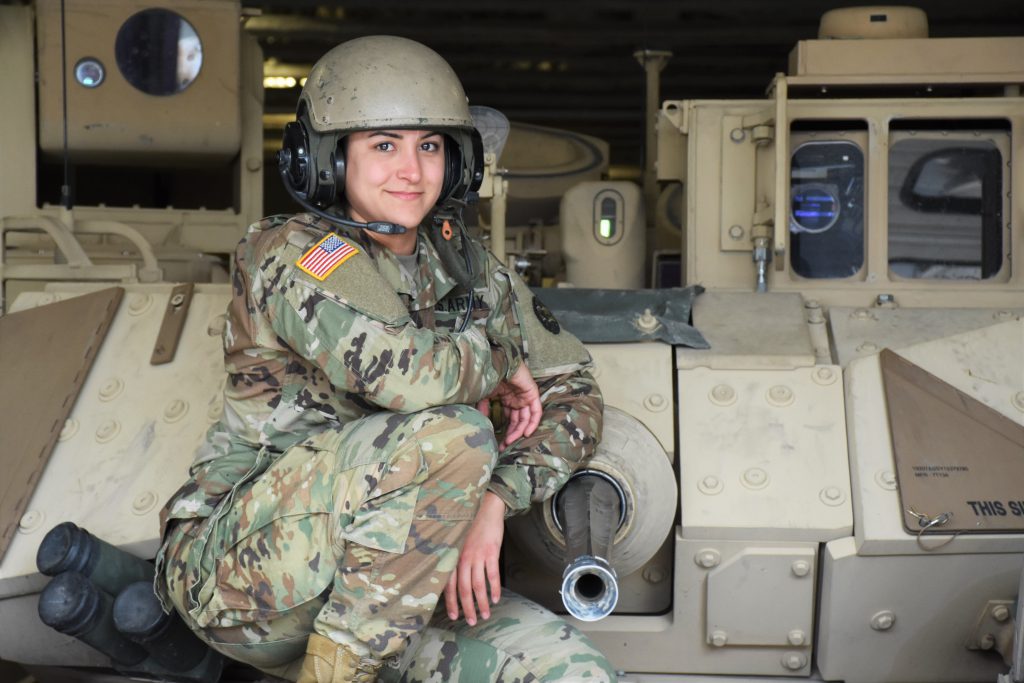
Story by Crystal Farris
Idaho Military Division Public Affairs
Last year, 1st Lt. Jessica Pauley made Idaho Army National Guard history by becoming its first female infantry officer. Her accomplishment is now helping pave the way for junior enlisted females within the organization to join the combat arms specialty.
“In 2018, Idaho’s only infantry company had no females and it could not be opened to junior enlisted Soldiers without a qualified female officer first,” said Pauley. “When I heard that, I knew I had to change my branch choice from ordnance to infantry because it was an opportunity to lead from the front.”
Before becoming an officer, Pauley enlisted into the Guard in 2014. She graduated from Advanced Individual Training as a public affairs specialist and returned home to enroll in the ROTC program at Boise State University. She earned her degree in media arts on a full scholarship while simultaneously serving in the Guard and earning her commission as second lieutenant in 2018.
Shortly after joining her new unit as an ordnance officer, Pauley met a Soldier who quickly influenced her decision to change branches.
“When I met Sgt. 1st Class Melanie Galletti, I saw her struggle with wanting to be in an infantry line unit but not being able to because of the Army’s leaders first initiative,” said Pauley. “I didn’t realize that was a problem at the time because I heard the Army had been integrating females since 2015.”
While the Army opened combat roles including armor and infantry to females in 2015, its leaders first initiative requires that a platoon first have a branch qualified female officer or a noncommissioned officer assigned to the unit before accepting junior enlisted Soldiers in the ranks of private through specialist. Other integration requirements include gender integration training and command climate surveys.
Pauley decided to become the organization’s first female infantry officer wanting to support the organization’s advancement in the integration and help female Soldiers realize their potential in combat arms.
“I knew I could do it and would regret it if I didn’t try,” said Pauley. “Everyone was very supportive of my decision and gave me the added push to go.”
Pauley graduated from the US Army’s Infantry Basic Officer Leaders Course in June 2019 and was assigned to the Idaho Army National Guard’s C Company, 2nd Battalion of the 116th Cavalry Regiment. As a platoon leader of a mechanized infantry unit, Pauley is responsible for training Soldiers in infantry tactics, both dismounted and mounted on M2 Bradley Fighting Vehicles.
“We’ve had females in our ranks for quite some time now in a variety of positions and they do a great job,” said Col. Benjamin Cook, 2-116th Cavalry Regiment commander. “It’s only fitting that they be allowed the same opportunities in all military occupational skills.”
C Company along with the battalion’s armor B Company, recently received authorization to assess its junior enlisted female Soldiers interested in serving in combat arms.
This milestone comes partly after Pauley and two other Idaho Army National Guard female officers became branch qualified and assigned to positions within the battalion’s units. Last year, B Company Soldiers, 2nd Lt. Brook Berard and 2nd Lt. Lauren Bolt, graduated from the U.S. Army’s Armor Basic Officer Leaders Course.
Prior to them, the Idaho Army National Guard saw several female enlisted Soldiers led the way by being the first to take advantage of the new integration standard and complete combat arms training courses.
In 2015, Idaho Guardsman 1st Sgt. Erin Smith became the nation’s first female enlisted Soldier to graduate from M1 Armor Crewman School. Following her, Staff Sgt. Kylene Huerta completed the same training and became the first female Soldier to briefly be assigned to the organization as a tank crew member. In 2017, Sgt. 1st Class Melanie Galletti graduated from the U.S. Army’s Infantryman Course as the Idaho Guard’s first qualified female enlisted infantry Soldier.
Despite their relatively new ability to serve in combat roles, females have been serving in the military since congress passed the Women’s Armed Service Integration Act in 1948, allowing them to serve as permanent members.
While being a female in combat arms is challenging, Pauley said it has also been rewarding to be part of an organization where she is treated equally in her combat role regardless of gender.
“There are so many people who want to see female integration into combat arms normal,” said Pauley. “The Guard has been moving and pushing for diversity and progress because it makes for more effective and dynamic fighting teams. We need quality people from all backgrounds and that’s what I hope to see over the course of my career in the Guard.”
Idaho National Guard helps in a time of need during the COVID-19 pandemic
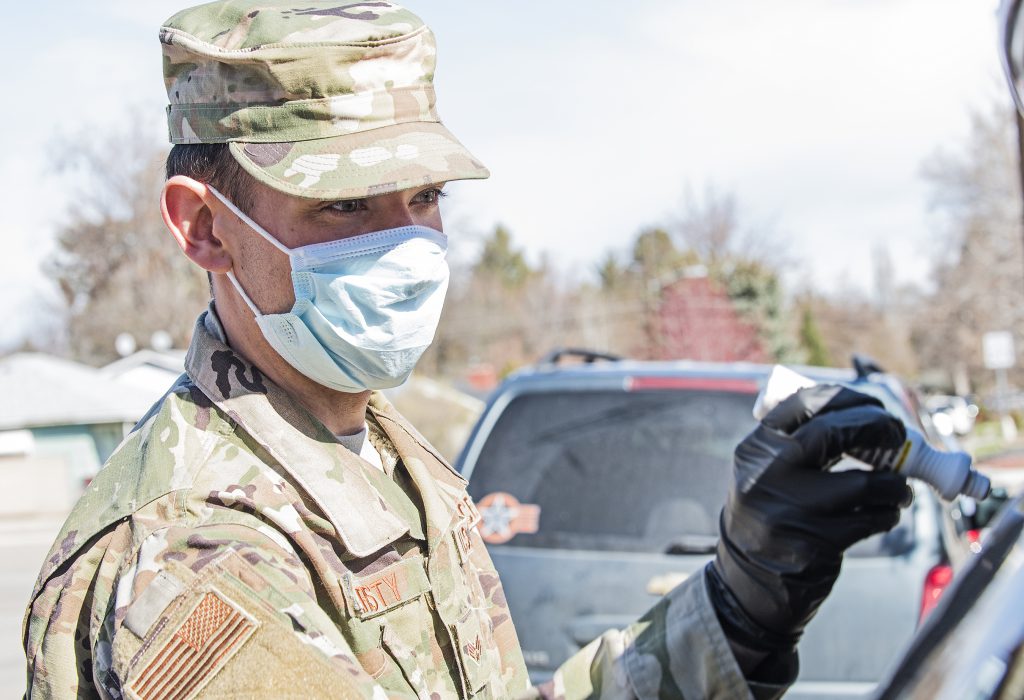
By Master Sgt. Becky Vanshur
Idaho Military Division Public Affairs
BOISE, Idaho – More than 40 Idaho National Guard Soldiers and Airmen are helping food bank workers keep up with increased demand as Idahoans start to feel the effects of the COVID-19 pandemic.
“We are so delighted to have this support from the Idaho National Guard,” said Karen Vauk, the Idaho Foodbank’s CEO and president. “We have to get more food in and more food out to support our communities across the state. We needed more manpower, so we called upon the National Guard.”
Citizen-Soldiers and Airmen were placed on state active duty orders in late March and assigned to work at the Idaho Foodbank’s Boise, Lewiston and Pocatello locations.
“We have more than 4,000 members in the Idaho National Guard,” said Maj. Gen. Michael Garshak, commander, Idaho National Guard. “We respond when the state, county or city organizations’ capacities are overwhelmed or stretched to the limit and they ask us to come in and help.”
Vauk requested additional assistance through the Idaho Office of Emergency Management after she noticed a significant increase of need in the food supply throughout Idaho, which was causing her operations to be spread thin.
Citizen-Soldiers and Airmen are also assisting at Boise’s St. Vincent de Paul Food Pantry by handing out donated groceries to those in need. The Idaho Foodbank donates food to pantries like St. Vincent de Paul as part of the Feeding America program.
“Before COVID-19, what we would see here at the pantry would be an average of maybe 1,100 families per month,” said Ralph May, executive director of St. Vincent de Paul. “During this crisis, we are seeing close to 2,300 families per month for now. We are seeing a little more than double and some days we are seeing three times the amount of families we would normally see in a day.”
Citizen-Soldiers and Airmen are assisting employees and volunteers with loading and unloading trucks, boxing and sorting donated food, helping load food into people’s cars and making deliveries to several of its 400 community-based partners throughout the state.
“Missions like this give people another reason to want to join the National Guard,” said Garshak. “Not only are they trained and prepared to serve our nation at times of war, but they are also ready and available to come to the aid of local communities and citizens in times of need.”
Family service: Father, three children serve together
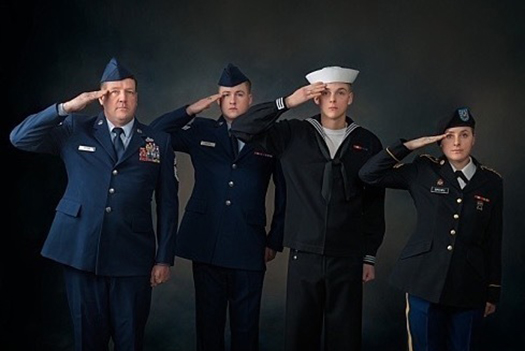
Story by Airman 1st Class Taylor Walker
124th Fighter Wing
In 1986, Idaho Air National Guard Command Chief Master Sgt. Sid Brown was itching to leave the small town of New Plymouth, Idaho. With the financial burden of college heavy on his mind, he met with an Air Force recruiter in Ontario, Oregon, He quickly found himself in uniform, working as an F-16C weapons load crew member at Ramstein Air Base, Germany.
He didn’t know it at the time, but he had just embarked on a career that would last more than three decades and see three of his children follow him into military service. As the Idaho Air National Guard’s senior enlisted leader, Brown is ending his career as his children begin their own careers, each in a different military branch.
“It means a lot to me to have my children serving,” Sid said. “I believe everyone who is able should serve in some capacity – even if they don’t join the military – and I’m very happy they’ve all chosen unique paths to do that.”
The first of Sid’s kids to join the military was Everett Brown, a traffic management specialist with the Idaho Air National Guard’s 124th Fighter Wing at Gowen Field. Now a senior airman, Everett said the military is engrained in his family history.
“We have a very long bloodline of military in our family, all the way back to when they stormed the beaches of Normandy, to Vietnam and the world wars,” said Everett. “The tradition has carried on from generation to generation. It’s an established part of our lives.”
For Everett, joining the Idaho Air National Guard was a way to honor his father and the experiences he had as a child on Gowen Field.
“As a kid, I watched my dad come home from deployments and saw the respect and pride he had and I wanted to feel that way,” Everett said. “My dad has always been my hero and it didn’t matter what branch I ended up joining, I just wanted to work hard the same way he did.”
Everett left for basic training the same day his sister, Kassandra, enlisted in the Idaho Army National Guard.
Cpl. Kassandra Brown is an ammunitions specialist in Golf Company, 145th Brigade Support Battalion. Although she wasn’t initially sure what branch she wanted to join, she knew the military was where she belonged.
“Joining the military felt like something I needed to do,” said Kassandra. “None of my friends were surprised when I finally joined. I feel like I’ve always had that decision in my heart.”
Kassandra said between the conflicting schedules and excessive pride, there’s a bittersweet feeling when it comes to having a family full of military members.
“I feel very proud of my family, but also scared at the same time because you never know what will happen to them,” she said. “But we all have cool stories to share. In our family you always have someone to talk to. You always have someone to relate to.”
Everett and Kassandra’s brother Wesley, who joined the Navy in June 2019, agreed that the support from their family is invaluable.
“They really understand what I’m going through, especially my dad who has had active duty experience,” said Wesley. “He takes time to answer all of my questions.”
Seaman Wesley Brown is a hospital corpsman at Wayne Caron Clinic, Camp Lejeune, North Carolina. Although his mom’s side of the family has a rich naval history, Wesley’s motivation for joining the military had less to do with his family’s history of service.
“I mostly wanted to branch out from Idaho and experience the world through a different lens than the rest of my family,” he said.
Regardless of their selected branch or individual reasons for joining, Wesley said the military establishes a common thread between him and his siblings.
“I take pride in my family because we’re all doing our part to serve our country,” said Wesley. “We come from a good background with strong morals.”
Although Sid has decades of experience and sits in a highly regarded position, he largely keeps his influence to himself when it comes to his children.
“I do my best to stay out of their careers,” Sid said. “Good, bad or indifferent, it’s their path.”
According to a 2013 Pentagon report, more than 82% of recruits across the Army, Navy and Air Force have a family member who has served in the military. Whether that’s the case or not for a military hopeful, Sid emphasized that it’s important for parents to be supportive of their children’s decisions.
“The military is a great career path,” he said. “Your kids will learn new skills, get great benefits and a great education. They’ll have to stay off drugs and they’ll potentially see the world. Don’t be afraid. Don’t stifle their decisions.”
Brother, sister serve together
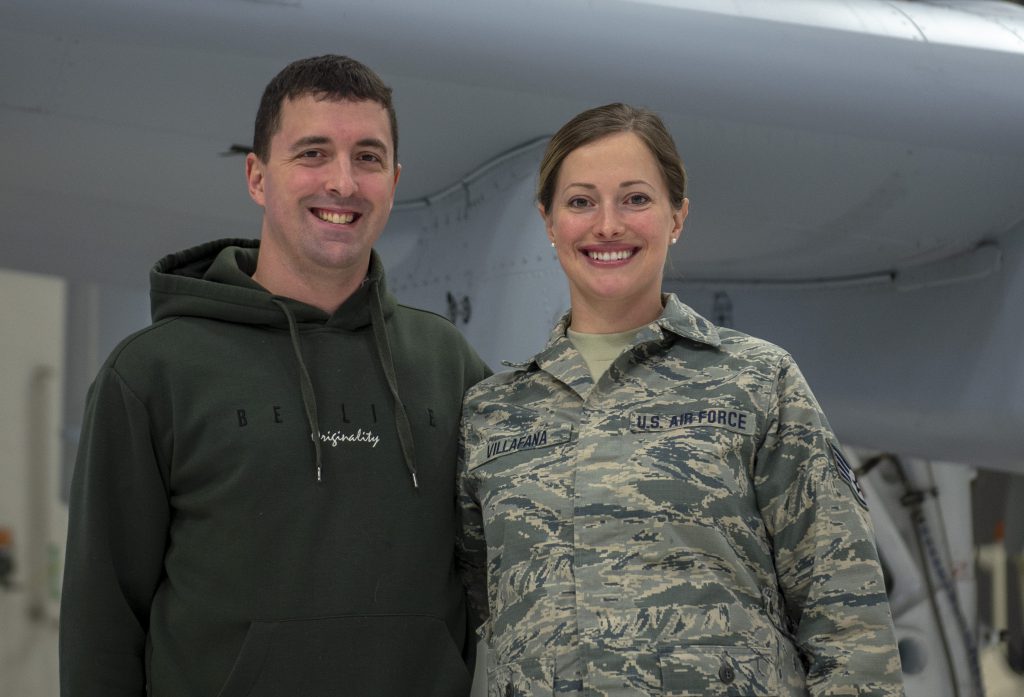
By Ryan White
124th Fighter Wing Public Affairs
Staff Sgt. Mason Allen and his sister, Staff Sgt. Camas Villafana, were both responsible for each other’s decisions to become Idaho National Guardsmen. Allen, who was the first to join the military, chose to enlist in the active duty Air Force in 2014. He then influenced his sister’s decision to join the Idaho Air National Guard in 2015. Now the siblings have come full circle. This year, Villafana influenced her brother’s recent decision to join the IDANG after leaving active duty.
One would think Allen, a former aircraft integrated avionics specialist for the A-10 Thunderbolt II, would be joining the IDANG to continue working on the A-10s. However, he is following in his sister’s footsteps and the two are serving side-by-side at the 124th Medical Group.
“I was considering joining the National Guard,” said Allen. “After talking to my sister, it allowed me to see what was available to me at this unit.”
While Villafana was looking into options for Allen, she learned about a recent vacancy her brother would be interested in. Allen did some research and decided she was right. Now, he is enlisted as the MDG’s newest biomedical equipment specialist.
“The job title alone tells me that it’s going to be more mechanically inclined,” said Allen. “I feel like that is something I became exceptional at in the job I had on the active duty side. I am excited to learn how to put those skills to use at a different job and also learn a whole new set of skills that I can apply later in a civilian job.”
Allen will have to attend a technical training school, for about a year and a half, sometime after September. Until then, he will be working at the MDG starting this month. For the first time, Allen and Villafana will be working together.
Villafana first started working at the MDG in 2015, when she became a part of the IDANG family. She is currently working full-time until April, just in time to begin planting and irrigating on the farm she and her husband operate in Wilder, Idaho. They grow sugar beet row crops. She says she appreciates the flexible schedule that comes along with the IDANG, allowing her to farm. This was one of the benefits that originally appealed to her about joining IDANG.
“I wanted to join the National Guard since high school,” said Villafana. “It kind of fell off my radar until after I graduated [college], when Mason joined the active duty Air Force. I started thinking about it more and talking to Mason. He was the one who helped me understand the different ins and outs of the different branches. I knew I wanted to join the Air Force, but I didn’t want to leave Boise.”
Villafana ultimately decided that joining the IDANG was the right choice for her and she’s glad she did. She says she enjoys the tight-knit relationships she has, which she may not have been able to develop, had she joined active duty instead.
Those close relationships and the flexibility with the IDANG, along with a new job opportunity, were ultimately what sold her brother on joining. Allen is looking forward to living closer to his family and continuing his Air Force career as an Idaho Guardsman alongside his sister.
A day in the life of an A-10 fighter pilot
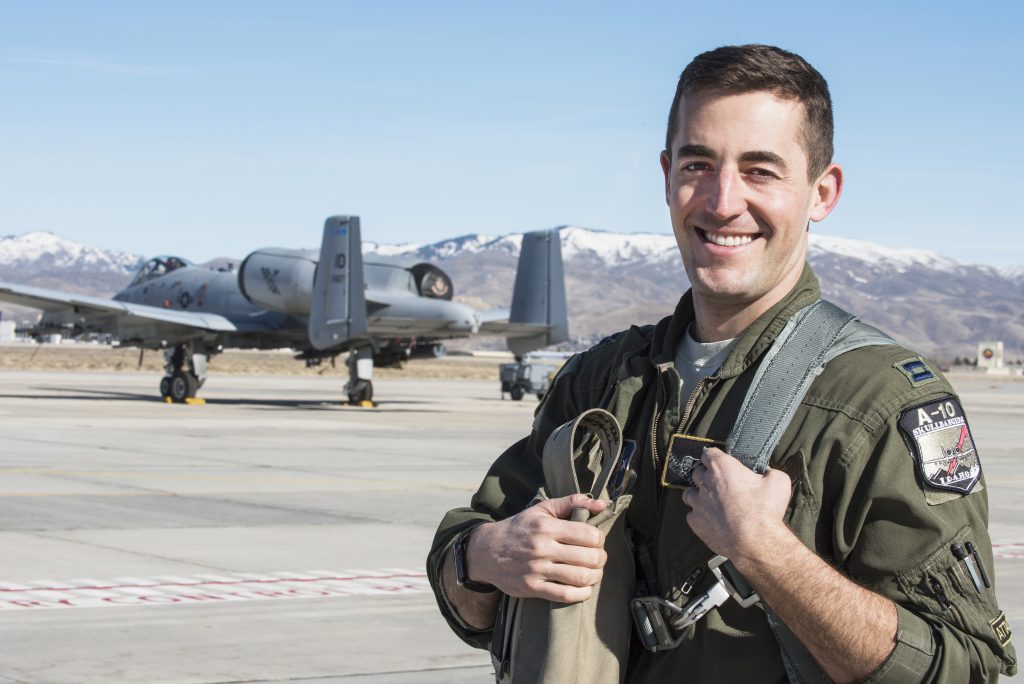
By Master Sgt. Becky Vanshur
Idaho Military Division Public Affairs
GOWEN FIELD, Idaho — Spend a day flying with Capt. Mike Shufeldt, one of the Idaho National Guard’s A-10 Thunderbolt II pilots, and feel firsthand what it is like to be an A-10 fighter pilot.
He can smell the strong scent of coffee brewing from the kitchen, as he brushes his teeth. It’s early in the morning, but his dog, Poppy, sits at his heels patiently waiting with a ball in her mouth and tail wagging. Shufeldt grabs his thermos of coffee, throws the ball a couple of times for Poppy, pats her furry head and walks out the door.
The commute across the Treasure Valley isn’t too bad as he heads down the interstate, even with the sun shining in his eyes as it rises above the beautiful Idaho foothills. Shufeldt approaches the main gate of Gowen Field, Boise’s Air Terminal and National Guard Base, with a smile on his face. Today is a good day to fly the mighty A-10 over the nearby Orchard Combat Training Center.
Shufeldt enters the building of the 190th Fighter Squadron and prepares for his day. He gets dressed in his flight G-suit, then his harness for his seat and parachute, and he grabs his high-tech flight helmet. Preparing for his flight and the training mission can take up to two hours. At the operations desk, he listens to his step brief. Today, he is called Bang 11.
The step brief is for him and his wingman, the additional pilot flying the second aircraft on this morning’s training mission. They are briefed on the weather, coordinates, weapons and the close air support mission they are about to fly.
“Bang 11, you are clear to step. Attack,” are the last words said before he heads out to the flight line where his A-10, commonly referred to as a Warthog, is patiently waiting. It is nearing 9 a.m. as he begins the 45-minute preflight check. He walks around his A-10, scanning for any visible issues.
“I do a full preflight inspection on the outside of the jet, to make sure there isn’t anything I see wrong,” said Shufeldt. “Usually there isn’t because our crew chiefs and our maintainers are really good. They are the best, actually.”
He climbs up the ladder and straps into his seat. He and his crew chief turn on the auxiliary power unit and fire up the twin turbine engines. “Clear on one,” said Shufeldt. “Good start on one,” is the response. “Clear on two.” “Two is clear,” is echoed back to him and the two engines are now fired up.
“We check everything, from the brakes to the rudders to the digital systems inside the jet,” said Shufeldt.
Both Warthogs are now ready for flight. “Pull the chalks, see you soon,” said Shufeldt. He disconnects with his crew chief, they salute and he taxis to the runway, stopping near the end to have his A-10’s weapons armed.
The powerful Warthogs line up. Shufeldt is out front. Once cleared for takeoff, he steps firmly on the brakes and runs up the engines. As he eases the throttles forward, the 12-and-a-half-ton beast starts to shake as it reaches nearly 20,000 pounds of thrust.
After checking his gauges and instruments, he pushes the throttles to maximum and releases the brakes. The mighty Warthog gains speed quickly, reaching approximately 150 miles per hour before he pulls back on the stick and the tires leave the runway.
He is up in the air. He takes a deep breath. A moment of calm, but it is short-lived as he begins his in-flight checks and focuses on the mission. He flies toward the target area.
The sun is just above and to the left, the heat from its rays beating down on his neck, the only portion of skin that is exposed.
He can see several dirt roads below in the vast desert and sagebrush-filled land of the OCTC as he approaches the target area near the ground troops below. They are providing ground support while shooting training targets.
“Bang 11 in from the south, guns,” said Shufeldt. “Bang 11, cleared hot,” said the ground troop on the radio below, providing Shufeldt clearance to shoot the 30 mm Gatling gun. “Bang 11, good hits,” is heard after the rounds are fired.
After expending all weapons, he has completed the training mission. Before flying back to Boise, the pilots check each other’s aircraft for any issues. This is called a battle damage check. The A-10s fly wingtip to wingtip, then Shufeldt dips below his wingman’s aircraft and looks up, checking the belly of the A-10. They switch positions and fly back in formation to Gowen Field.
Shufeldt lands, taxis the satisfied Warthog back to the flight line and parks in the same spot in which he started. He reverses the order of the prefight for the shutdown procedures with the crew chief. Once inside, he debriefs the mission with his wingman. It is nearing 1:30 in the afternoon and he is hungry. He warms his lunch, a stir-fry he cooked the night before.
Pilots, like any Airman, have additional military training and duties. He completes these, spends an hour at the gym and heads home.
He walks through the front door with barely enough time to close the door behind him as Poppy jumps up as high as she can, almost knocking him over. Shufeldt is home now after a day in his life as an A-10 fighter pilot.
 Official Government Website
Official Government Website